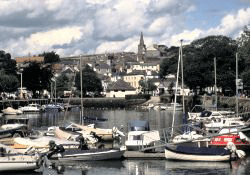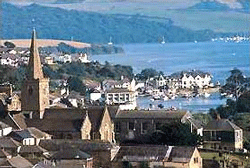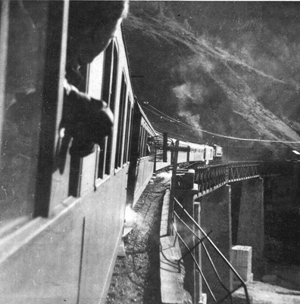The same discipline training continued at Tonfanau. It was here that we were confronted with the 3.7 gun, the Sergent in charge gave us all a good knowledge of how to maintain, dismantle and fire it. We all had to learn each others position on the gun in case one of the members of the team was killed in action (that was a sobering thought!)
The gun had a large barrel and was transported on a trailer consisting of four legs and wheels, towed by an AEC Matador lorry. Each leg had to be raised for the travelling position and lowered for the firing position. Other positions for the team of gunners were Traverse Operator, Elevation Operator, Tannoy Operator, and Ammunition Operator who had to lift a round up and put it in the breach and finally, the Sergeant who had the responsibility of firing. The first time I lifted a round of ammunition, my knees buckled as they were very heavy for a nine stone weakling, which I was at the time.
After a days work, we used to go into the gymnasium and use all the apparatus to see if we could build some muscle, after which we were able to play football on the sports pitch until dusk as it was summer at the time. I remember one of the lads being called ‘Stubbs’, his full name was Les Stubbs and for those of you who know your football, you will recognise the name as he was the same Les Stubbs who after his National Service played for Chelsea. He played in 123 matches and scored 35 goals from the inside forward position from 1952 to 1958. In the 1954-55 season he helped Chelsea to win their first league title. We practiced with him on the Tonfanau pitch for hundreds of hours.
I think our pay was about one pound and five shillings, I think they were making sure that we couldn’t go mad in our leisure time. You could always tell the well off, because their parents used to send them extra money.
We had a regular T.A.B. (Typhoid, Paratyphoid A&B) inoculations at Tonfanau. The Seargent got us all together, marched us up to the MO room and stood us in a queue. I could see some of the lads were scared so I volunteered to be the first in the queue. They all thought I was either very brave of very mad, but my theory was that if I was first then the needle would be sharp for me and blunt for the rest, it worked for me as I got it over and done with and didn’t feint, like a couple of lads in the queue did. Of course, after about eight weeks it suddenly dawned on us what all the inoculations were for.
We were given a fortnight’s embarkation leave and told to report back to RA Barracks, Woolwich, London where we would then be ‘en route’ for EGYPT
.
Up to this time, the farthest place I had been to was Leeds and Huddersfield to watch football, except for the Carleton Homes trips to Skegness when I was about eight years old and in care.
Before going into the Army I was lodging with an Aunt at the time in Pontefract, but the circumstance there were very difficult so I decided to spend my two weeks embarkation leave in Kingsbridge, Devon with my older sister. Mary had been sent to Devon when she joined the Women’s Land Army, and this is where she had met and married her husband, Douglas Rowe.

Kingsbridge - Devon |
|
I travelled to Plymouth by train and arrived around midnight. I had struck up a conversation with an elderly gentleman in my carriage and he told me that I wouldn’t be able to get a bus to Kingsbridge that late at night. He said he had a car waiting for him at Plymouth Railway Station and offered to drop me off at the Sailor’s Hostel which was across the city. This he did and on getting out of the car he said “Good luck in Egypt” This happened in 1949, when you could trust people, I wouldn’t do that today but I was grateful to that gentleman back then! |
It was now late summer, the next morning I got a bus to Kingsbridge and set off to find my sister, she was living at 100 Fore Street in rented accommodation with her husband, Douglas. Kingsbridge is situated in one of the most beautiful parts of Great Britain, called the “South Hams” which means hamlets. It has the most beautiful beaches and quaint coves. Local areas include Salcombe, Totnes, Newton Abbot, Dartmouth, Brixham, Bigbury, Thurlestone, Beesands and many other equally beautiful places. |
|

Kingsbridge - Devon |
Torquay lies twenty miles to the east and Plymouth lies about twenty miles to the west. The weather was glorious; I met Douglas’s relations while there and vividly remember a great day spent blackberrying with Brian Rowe. At that time, Douglas’s mother and father lived in a large detached house on the outskirts of Kingsbridge on the Totnes road. I spent one of my two weeks widening their twenty yard drive up to the house; all the lanes were narrow with large earth banks on either side and driveway entrances were very dangerous. The following week, Douglas drove me all over the area in his old Armstrong Siddely and he also took me to Salcombe where he hired a small motor boat and we fished for Mackerel…. Great stuff!
It’s strange to go back there now, Douglas’s father owned eleven acres of land and four houses very close to the town centre at that time, today there are hundreds of houses built on the land.
A few years later, my new wife Dorothy and I went back to Devon and fell in love with this beautiful little part of the world, in future years we would take our children there every year for their summer holidays.
Woolwich Barracks & Square - London
Headquarters of the Royal Artillery Regiments |
I really enjoyed my time in Devon for that fortnight. But as all good things go, it flew by far too quickly and now I was making my way to Woolwich Barracks, London where I would start what was to be a very long, but exciting trip to Egypt.
We were told we would be taking the ' Med-Loc' route, which I means the route crosses the Mediterranean by boat and then carries on via locomotive, it's the route that links Europe with the Middle -East. We were issued with KD ( khaki drill ) shirt, shorts, socks and puttees etc., for the hot weather in Egypt. We were ordered to assemble on the Barrack Square and at 7pm I set off on the trip of a lifetime.
It was October 1949, we were marched down to Woolwich tube station in the dark. From there we went onto one of the Mainline London railway stations (I can't remember which one!) where we changed trains for our journey to Harwich. We certainly got a few funny glances from Joe public, who must have been wondering what was going on, 50 young soldiers, all with kitbags swinging and trying to keep up with our Sergeant in charge.
We arrived at Harwich on the dockside at around 11pm where a ship was waiting to take us to the Hook of Holland. We boarded the ship and soon settled down in our bunk-beds for the night.
Next morning we awoke and disembarked to be ushered into what looked like a transit camp on the dockside, we had a good square meal and then made our way to a train which was waiting to take us on the next leg of our journey to Trieste in Italy sometime in the next few days.
We had been issued with red and green plastic money for meals en-route.

Train journey through the Alps |
|
HOOK OF HOLLAND TO TRIESTE
BY RAIL
On the train, four of us were allocated to each compartment which had four custom made long cushions that acted as a bed for the nights on our journey. We had just started our trip when we got a good smell of smoke and steam, this was what the age of steam was all about, and we were quick to make a dash to close the windows when we went through the tunnels.
Someone produced a map and we plotted the route which was going to take us through parts of Holland, Germany, Austria and Italy. There was plenty of sightseeing to do as we passed through each country and we had the freedom of a corridor.
|
There was a lot of card schools going on, I had never played cards and I had very little money anyway, so I didn’t bother with it.
The train stopped several times going through Holland and Germany, I remember when we reached one of the stations that I was amazed to see thousands of two inch pieces of metal welded on to the engine to cover up the bullet holes that the RAF must have strafed them with in the1939-45 war, which was only four years ago. We had a good look as we could almost touch the engines.
Halfway through Germany it began to snow and we had beautiful views of the pine forests and villages in both the day and evenings, you could see cottages with lights in the windows.
The train driver stopped the train in Austria on a viaduct hundreds of feet up one day, I think he must have done it for our benefit because it was a beautiful sight, what a pity none of us had a camera.
We journeyed on and the train must have traveled under the Alps because our next stop was Villach in Austria, where we spent half a day in a transit camp spending some of our plastic money. This was a pleasant change from the train.
The next thing that I can remember was that we were all steaming into Trieste, dockside, where the Australian ex passenger liner The 'HMAS WESTRALIA' was waiting at her berth. She was ready to take us to our final destination of FAYID in EGYPT . . . and the trip of a lifetime !
........................................... . . .look out for Part 2 of Stan's National Service story coming soon . . .
|


